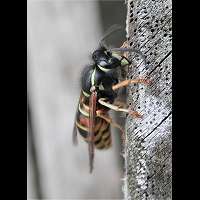Red Wasp Vespula rufa
The Red Wasp is black with yellow lines, except for the first part of the abdomen, which is brownish red or has some brownish red patches. This makes it very similar to the hornet. The latter is much bigger though and has red markings on the thorax too. The markings on the Red Wasp's thorax are always yellow, never red. Together with the Hornet and dark specimens of the Median Wasp the Red Wasp is one of the very few Yellow Jackets which can be identified in the field easily. Queens have a bodily length of 17 to 20mm. Workers reach a length of 12 to 16mm and the males usually are some 13 to 17mm long.
By the end of March or the beginning of April the queen will be looking for a good place to build a nest. It is constructed underground in an abandoned mouse nest or similar cavity. The nest remains very small, for the diameter rarely ever is over 20cm. The paper is chewed from old, weathered, but dry wood. It is the same material used by the German wasp and the two species are regularly seen together chewing at old garden furniture, unpainted fences or poles etc. The nests are of the same light greyish colour. The outside of the nest of the Red Wasp is very smooth indeed and there are no air chambers. Inside the nest are 3 to 5 combs. At its peak some 700 animals (including eggs, larvae and pupae) inhabit the nest. Yet there are only some 100 to 300 workers, for the Red Wasp is a very efficient animal. To bring up one queen, only 1.1 worker is needed. The Common Wasp for instance uses over 10 workers just to breed one queen! The new queens of the Red Wasp and the males appear by the end of August. Usually all Red Wasps have disappeared before the end of September: all males and workers are dead, the new queens have found a place for overwintering. The Red Wasp hardly ever stings, not even in the vicinity of the nest. You should really stand on the nest, to get this species worked up. However the sting apparently is more painful than the sting of other Yellow Jackets. In autumn it will never bother us at our terrace or in our gardens. The nest might be taken over by a cuckoo wasp: the Austrian Wasp. The latter is a very rare species and little is known about its life cycle.
The Red Wasp is not nesting in the vicinity of man as often as the German Wasp and the Common Wasp do. The nests are much smaller too. As a consequence the Red Wasp is not as often seen as these other species. Still the Red Wasp is a very common, often even abundant pecies in the moderate climate zone of the Northern Hemisphere: Central and Northern Europe (not in the south), Northern Asia, Japan, Canada and the USA. Even though the nest may be made in parks or gardens, the species prefers heaths, light forests and moors.
The Red Wasp is black with yellow lines, except for the first part of the abdomen, which is brownish red or has some brownish red patches. This makes it very similar to the hornet. The latter is much bigger though and has red markings on the thorax too. The markings on the Red Wasp's thorax are always yellow, never red. Together with the Hornet and dark specimens of the Median Wasp the Red Wasp is one of the very few Yellow Jackets which can be identified in the field easily. Queens have a bodily length of 17 to 20mm. Workers reach a length of 12 to 16mm and the males usually are some 13 to 17mm long.
By the end of March or the beginning of April the queen will be looking for a good place to build a nest. It is constructed underground in an abandoned mouse nest or similar cavity. The nest remains very small, for the diameter rarely ever is over 20cm. The paper is chewed from old, weathered, but dry wood. It is the same material used by the German wasp and the two species are regularly seen together chewing at old garden furniture, unpainted fences or poles etc. The nests are of the same light greyish colour. The outside of the nest of the Red Wasp is very smooth indeed and there are no air chambers. Inside the nest are 3 to 5 combs. At its peak some 700 animals (including eggs, larvae and pupae) inhabit the nest. Yet there are only some 100 to 300 workers, for the Red Wasp is a very efficient animal. To bring up one queen, only 1.1 worker is needed. The Common Wasp for instance uses over 10 workers just to breed one queen! The new queens of the Red Wasp and the males appear by the end of August. Usually all Red Wasps have disappeared before the end of September: all males and workers are dead, the new queens have found a place for overwintering. The Red Wasp hardly ever stings, not even in the vicinity of the nest. You should really stand on the nest, to get this species worked up. However the sting apparently is more painful than the sting of other Yellow Jackets. In autumn it will never bother us at our terrace or in our gardens. The nest might be taken over by a cuckoo wasp: the Austrian Wasp. The latter is a very rare species and little is known about its life cycle.
The Red Wasp is not nesting in the vicinity of man as often as the German Wasp and the Common Wasp do. The nests are much smaller too. As a consequence the Red Wasp is not as often seen as these other species. Still the Red Wasp is a very common, often even abundant pecies in the moderate climate zone of the Northern Hemisphere: Central and Northern Europe (not in the south), Northern Asia, Japan, Canada and the USA. Even though the nest may be made in parks or gardens, the species prefers heaths, light forests and moors.





